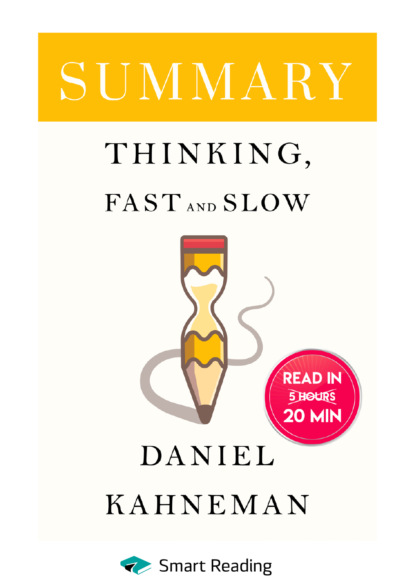По всем вопросам обращайтесь на: info@litportal.ru
(©) 2003-2025.
✖
Summary: Thinking, Fast and Slow. Daniel Kahneman
Настройки чтения
Размер шрифта
Высота строк
Поля
Smart Reading
Smart Reading. Ценные идеи из лучших книг
Notice: This is a SUMMARY of “Thinking, Fast and Slow” by Daniel Kahneman.
Daniel Kahneman's book Thinking, Fast and Slow, is dedicated to the workings of human thought. It was the result of scientific research for which the author received the Nobel Prize in Economics. Thinking, Fast and Slow by Daniel Kahneman proves that any normal person can make systematic errors in reasoning, especially in the face of uncertainty. These mistakes are inherent in a person’s true nature, his or her emotional state does not play a role. The author divides the mechanism of human thinking into two systems. System one uses associations and metaphors to casually sketch reality. System two uses reasoned and considered judgments, but is reluctant to get involved. People are looking everywhere for easy solutions and therefore quickly finds patterns where there are none.
Summary: Thinking, Fast and Slow. Daniel Kahneman
Автор:
Daniel Kahneman
Оригинальное название:
Thinking, Fast and Slow
www.smartreading.ru
Two Systems of Thinking
We can usually tell what we're thinking. The process of thinking seems clear: one conscious thought naturally causes the next one. But basically, the mind works differently. Most of our thoughts arise in unknown ways, and the mental work that leads to impressions, hunches, and decisions usually goes unnoticed.
There are two modes of thinking. To define the first mode – intuitive, spontaneous – the term "fast thinking" is used, and the second one – conscious, reasonable – is called "slow thinking".
Fast thinking activates automatically and instantly, requiring little or no effort. Slow thinking involves having the attention necessary for conscious mental effort, including complex calculations. Fast thinking generates impressions and feelings, while slow thinking actions are often associated with a sense of activity, choice, and focus. The automatic actions of fast thinking build complex patterns of thoughts, but only slow thinking can build them into an ordered sequence. Both systems have their own unique abilities, limitations and functions. What can fast thinking do? For example, it allows us to determine which of two objects is closer, discern the source of a loud sound, make a grimace of disgust at the sight of a disgusting picture, drive a car on an empty road, understand a simple sentence, reveal hostility in our voice, etc. These actions happen automatically and require no effort. The ability to think fast is our inner skill. We are born ready to perceive the world, recognize objects, avoid losses and be afraid of spiders. Other activities of the mind become fast and automatic after much practice.
Fast thinking includes expert knowledge and unconscious attitude, as well as all those absolutely automatic actions of the brain in the field of perception and memory that help us remember exactly the capital of England or recognize that there is a lamp on the table. But from time to time a reasonable answer doesn't come to mind, and in such cases we switch to a deeper form of thinking that requires more effort. This is slow thinking. With the help of slow thinking, you can prepare for the start signal in the race, hear the voice of the right person in a crowded noisy room, remember a sound that startled you by rummaging through your memory banks, intentionally speed up your pace, dictate your phone number to the person you are speaking to, etc. In all these situations, you need to be attentive, and if you are not ready or distracted, you will fare even worse, if not manage at all. One of the main functions of slow thinking is to monitor and control the thoughts and actions prompted by fast thinking.
Slow and fast thinking can interact. Fast thinking works automatically, while slow thinking works in a comfortable mode of minimal effort. Fast thinking constantly generates offers for slow thinking: impressions, premonitions, intentions and feelings. If slow thinking approves of them, then impressions and premonitions turn into convictions, and impulses into intentional actions. When everything goes smoothly – and it almost always does – the slow thinking accepts the offer of the fast thinking with little or no change. As a rule, you believe your impressions and act according to your desires, which is quite acceptable.
When fast thinking encounters difficulties it turns to slow thinking to solve the problem at hand with more detailed processing. That is, slow thinking tries to answer the question that fast thinking does not have an answer to. For example, do the math of 17 × 24. In other words, slow thinking comes into play when a question is discovered to which fast thinking has no answer. Slow thinking is responsible for the constant control of your behavior. Thanks to slow thinking you are able to remain polite in a rage and attentive when driving at night. Slow thinking is mobilized if it detects that you are about to make a mistake. Like when you remember how you almost blurted out something offensive and how difficult it was for you to control yourself. In general, most of what you (your slow thinking) think and do is generated by fast thinking, but in times of difficulty, slow thinking takes control and usually has the final say.
The division of labor between the two systems is very efficient. Most of the time, everything is fine, because fast thinking does its job very well: it forms accurate models of situations and short-term forecasts, and quickly responds to new tasks. However, fast thinking also has its distortions and systematic errors that it tends to make in certain circumstances. At times, it answers not what was asked, but an easier questions and is therefore poorly versed in logic and statistics. Another limitation of fast thinking is that it cannot be turned off. When you see a word in a familiar language on the screen, you will read it, unless your attention is diverted by something else.
Conflict of Two Systems of Thinking and Self-control
It often happens that you feel a conflict between the task you intended to perform and the automatic response that interfered with it. It's hard not to stare at an oddly dressed couple in a restaurant or focus on a boring book when suddenly we find ourselves constantly returning to a page where we failed to grasp what the author meant. Almost everyone has had to restrain himself so as not to send tell someone off, just like drivers who find themselves on an icy road and need to resist their natural reactions and instead follow the accepted instruction "steer into the direction of skid and do not slow down!". In other words, slow thinking is responsible for self-control.
The difference between impressions and beliefs can be huge. In the figure below you see the famous Müller-Lyer illusion. You have already measured the lines with a ruler and you know for sure that they are identical in length. But the lines are drawn in such a way that one of them seems to be longer than the other. And although slow thinking already knows that the lines are the same, fast thinking, which cannot be stopped and which perceives everything automatically, will still see lines of different lengths and assume that the lower one is longer. To counter the illusion, learn to mistrust your first impressions.
People are overconfident and tend to trust their own intuition too much. Many are repelled by mental effort, and they try to avoid it in every possible way. People often mistake the most plausible answer for the correct one. After all, it takes a much effort to toss it to the side: logic is not easy to test in the presence of persistent conviction. If people believe in the truth of any statement, they will willingly believe even untenable arguments in support of it. Fast thinking works automatically and cannot be turned off at will, making it difficult to prevent errors. Prejudices are not always avoidable, as the slow thinking may simply not be aware of the error. Mistakes can be avoided only if the slow thinking will specifically monitor this and make additional efforts. But to live your whole life on the alert is also not very good and impractical. Besides, slow thinking cannot replace fast thinking for making everyday decisions because it is so slow. The best thing to do is to compromise: learn to recognize situations where mistakes are possible, and try your best to avoid serious mistakes if the stakes are high.
Associative Machine
When you saw the words "bananas" and "vomit", you immediately imagined unpleasant pictures, grimaced in disgust, most likely reacting to the disgusting word. This happened automatically and without your control. The mind independently established a causal relationship between these words, and the whole complex set of reactions manifested itself quickly and effortlessly: one thought caused another, spreading a wave of activity in the brain. All this was done by fast thinking.

















